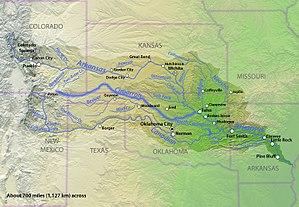
Back ሲማሮን ወንዝ Amharic نهر سيمارون Arabic نهر سيمارون (نهر) ARZ سیمارون چایی AZB Cimarron River (suba sa Tinipong Bansa, Oklahoma) CEB Hotóao'hé'e CHY Cimarron (přítok Arkansasu) Czech Симаррон (юханшыв) CV Cimarron River Danish Cimarron River (Arkansas River) German
| Cimarron River | |
|---|---|
 The Cimarron River, near Forgan, Oklahoma | |
 Map of the Arkansas River basin with the Cimarron River highlighted. | |
| Etymology | Río de los Carneros Cimarrones (Spanish for 'River of the Wild Sheep') |
| Native name | |
| Location | |
| Country | United States |
| State | Colorado, Kansas, New Mexico, Oklahoma |
| Cities | Cushing, Oklahoma, Mannford, Oklahoma, Guthrie, Oklahoma |
| Physical characteristics | |
| Source | Confluence of Dry Cimarron River and Carrizozo Creek |
| • location | Kenton, Cimarron County, Oklahoma |
| • coordinates | 36°54′24″N 102°59′12″W / 36.90667°N 102.98667°W[1] |
| • elevation | 4,318 ft (1,316 m) |
| Mouth | Arkansas River |
• location | Keystone Lake, at Westport, Pawnee County, Oklahoma |
• coordinates | 36°10′14″N 96°16′19″W / 36.17056°N 96.27194°W[1] |
• elevation | 722 ft (220 m) |
| Length | 698 mi (1,123 km) |
| Basin size | 18,950 sq mi (49,100 km2) |
| Discharge | |
| • location | Guthrie, Oklahoma, 65 miles (105 km) from the mouth[2] |
| • average | 1,163 cu ft/s (32.9 m3/s)[3] |
| • minimum | 0.3 cu ft/s (0.0085 m3/s) |
| • maximum | 158,000 cu ft/s (4,500 m3/s) |

The Cimarron River (/ˈsɪmərɒn, -roʊn/ SIM-ə-ro(h)n; Iowa-Oto: Ñíxgu or Ñíhgu, meaning 'Salt River';[4] Cheyenne: Hotóao'hé'e) extends 698 miles (1,123 km) across New Mexico, Oklahoma, Colorado, and Kansas. The headwaters flow from Johnson Mesa west of Folsom in northeastern New Mexico. Much of the river's length lies in Oklahoma, where it either borders or passes through eleven counties. There are no major cities along its route. The river enters the Oklahoma Panhandle near Kenton, Oklahoma, crosses the corner of southeastern Colorado into Kansas, reenters the Oklahoma Panhandle, reenters Kansas, and finally returns to Oklahoma where it joins the Arkansas River at Keystone Reservoir west of Tulsa, Oklahoma, its only impoundment. The Cimarron drains a basin that encompasses about 18,927 square miles (49,020 km2).[5]
- ^ a b U.S. Geological Survey Geographic Names Information System: Cimarron River (Arkansas River tributary)
- ^ "USGS Gage #07160000 on the Cimarron River near Guthrie, OK" (PDF). National Water Information System. U.S. Geological Survey. 1938–2009. Archived (PDF) from the original on March 19, 2012. Retrieved November 21, 2010.
- ^ "USGS Gage #07160000 on the Cimarron River near Guthrie, OK" (PDF). National Water Information System. U.S. Geological Survey. 1938–2009. Archived (PDF) from the original on March 19, 2012. Retrieved November 21, 2010.
- ^ (2008) Kansas Historical Society, Ioway-Otoe-Missouria Language Project, English to Ioway-Otoe-Missouria Dictionary, "Dictionary X (English to Baxoje)", "Cimarron River". Link
- ^ Larry O'Dell, "Cimarron River," Encyclopedia of Oklahoma History and Culture. Archived April 2, 2015, at the Wayback Machine Accessed March 6, 2015.